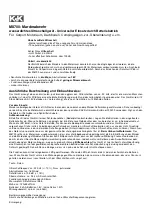
Vascular flow
detection
The
PD1 combi
/
PD1+ combi
can be used to detect both surface
vessels, deeper arteries and veins using either the 5MHz or 8MHz
transducers.
To obtain the best signal, apply a liberal amount of coupling gel to
the area of the vein or artery under investigation. Tilt the transducer
at approximately 45 degrees to the vessel. Arteries give a high
pitched pulsatile sound, with veins giving a sound like a roaring
wind. The optional headset helps to eliminate ambient noise, making
it easier to detect the weaker signals.
It is also usual for the
PD1 combi
/
PD1+ combi
to be used in
association with a pressure cuff and sphygmomanometer to indicate
the location and extent of arterial occlusion in the form of ankle/
brachial pressure index and segmental pressures.
Due to the variation of leg blood pressure over a wide range with the
systemic pressure, the actual values are less useful than the
pressure index, which relates the ankle pressure to the pressure
obtained at the brachial artery. Using the
PD1 combi
/
PD1+ combi
to measure both pressures will ensure compatibility. In cases where
patients have peripheral arterial disease using the
PD1 combi
/
PD1+ combi
, due to its high sensitivity, can be the only technique
suitable for the measurement of leg blood pressure.
Pressure Index = Ankle systolic pressure
Brachial systolic pressure
Normal - ankle systolic pressure > brachial pressure.
Normal pressure index >1
Abnormal pressure index <1
Summary of Contents for PD1+ combi
Page 1: ...PD1 combi PD1 combi operating instructions ultrasound technologies...
Page 2: ......
Page 11: ......





























